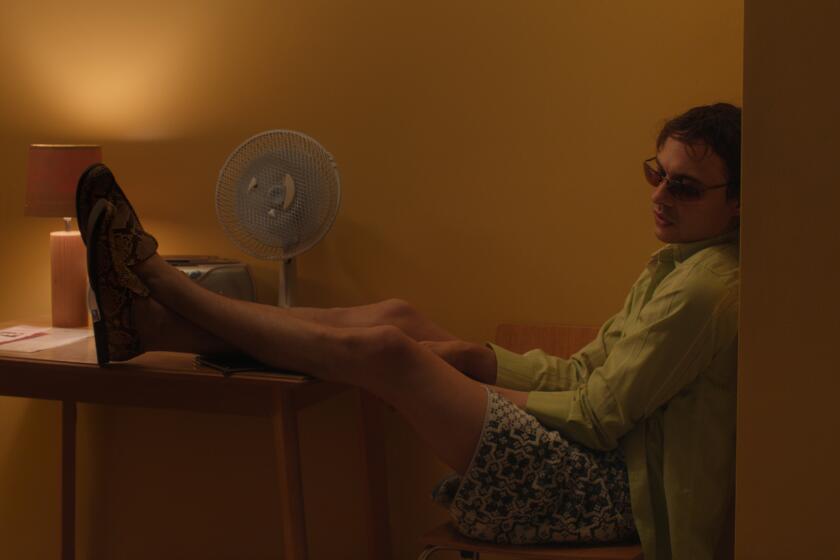Two Sides of the Same Conundrum
- Share via
In the mood for a mother-daughter drama? As of Wednesday, local moviegoers will have two to choose from--Fine Line Features’ “Tumbleweeds” and 20th Century Fox’s “Anywhere but Here”--but they’re about as similar as Carrie Fisher and Debbie Reynolds.
True, the moms in both movies are headstrong, sexy, occasionally selfish women who like to wear loud prints. Their daughters are both wise-for-their-years--the kind of kids who give sage romantic advice but still like to be tucked in at night. Both twosomes drive cross-country to make a better life in California. Both exchange sharp words when daughter gives mother a much-needed reality check.
But in origin and execution, these are very different films. “Tumbleweeds” was made for about $1 million. “Anywhere but Here” cost more than 20 times that and has a marketing budget to match. “Tumbleweeds” features relative unknowns--Tony-winning British actress Janet McTeer and Kimberly J. Brown--and a first-time director. “Anywhere but Here” has major star power: Susan Sarandon and Natalie Portman, with Wayne Wang (“The Joy Luck Club”) at the helm.
“Tumbleweeds,” which opens Wednesday in limited release, is gambling that good word of mouth will help support gradual expansion to other markets. “Anywhere but Here” bet the farm all at once, bowing two weeks ago on nearly 1,700 screens across the nation. It hasn’t paid off very well so far, grossing a lackluster $10 million to date.
“This is very much a David-and-Goliath situation, and we’re literally fighting a ground war. You have to take every trench--critic by critic, city by city, audience member by audience member, or it’s not going to work,’ said Mark Ordesky, Fine Line’s president, who acquired “Tumbleweeds” at the Sundance Film Festival last January.
Even though the $23-million production budget for “Anywhere but Here” is quite modest in Hollywood terms (all the participants cut their rates to make the film), its proximity to “Tumbleweeds” has created a classic indie vs. Hollywood battle, with the two films’ near-identical subject matter only fueling the rivalry. What’s fascinating, though, is that for “Tumbleweeds,” the disadvantage of underdog status may be turning into a strength. The odds may not be as stacked as they first appear.
In pure economic terms, a tiny production and marketing budget means that “Tumbleweeds” needs to lure fewer moviegoers to turn a profit (which is key, since the film has no hope of luring the biggest box-office juggernaut: teenage boys). And the movie’s little-known cast members--whose very unfamiliarity, ironically, is being credited with lending their roles credibility--are suddenly getting pegged as “discoveries” whose must-see performances could even garner Oscar nominations.
Line Blurring Between Indie, Studio Films
Can star-driven Hollywood movies pull off an unflinching, realistic look at family life? The question is likely to pop up more and more as the lines between independent and studio productions become more blurred and Hollywood delves into darker and more nuanced topics (like the upcoming studio adaptations of the acclaimed books “Angela’s Ashes” and “Snow Falling on Cedars”).
The screenplay for “Anywhere but Here” was written by Alvin Sargent, a two-time Oscar winner (for “Julia” and “Ordinary People”), who adapted the script from Mona Simpson’s acclaimed book. Laurence Mark, the film’s producer, received an Academy Award nomination for producing “Jerry Maguire.”
But despite the pedigree, some critics found Sarandon’s role simply grating, while others faulted the whole movie for not ringing true enough. The film didn’t make the mistake of other recent so-called “chick flicks” that mistakenly sought to draw women with subject matter that many find simply repellent (the stolen-child drama “The Deep End of the Ocean,” for example, or the marriage-on-the-rocks saga “The Story of Us”). Instead, some critics said “Anywhere but Here” took a topic that interests women (think “Postcards From the Edge”) and botched it.
By contrast, the screenplay for “Tumbleweeds” was written by a couple of first-timers: Gavin O’Connor and Angela Shelton. Their source material was Shelton’s unpublished stream-of-consciousness memoir about her unconventional childhood on the road with her vivacious mom.
O’Connor, who would eventually direct and co-star in the film, and Shelton were married when they began writing the script. They were divorced by the third draft, but were so wedded to the project that they kept working. Along the way, they cast McTeer as the elder lead after O’Connor saw her on the “Charlie Rose” show.
After the eighth draft, with McTeer attached, they approached Hollywood’s mini-major studios (Fox Searchlight, Sony Classics, Miramax and the like) seeking about $2.7 million in financing to shoot the movie. Even at Fine Line, which would later buy the completed film, they struck out--primarily, they recall, over the very decision they’re being lauded for now: casting McTeer.
“The mini-majors said, ‘Nice script. And Janet McTeer is brilliant. But she’s a British theater actress and 99.99% of the country has never heard of her,’ ” O’Connor said. “But my mantra for this movie was it’s a documentary within the context of a drama. I wanted you to feel privy to very intimate, private moments between a mother and daughter. I didn’t want the audience to have any memory of these actors from any other roles.”
They set out to finance the film themselves--Shelton maxed out her credit cards, O’Connor sold all his stock in his father’s company and hit up his whole family for cash. And they kept revising the script, eventually penning 14 drafts in the hopes of perfecting something else that Hollywood is not usually known for--what O’Connor calls “swimming in the gray.”
“Hollywood makes a lot of great movies, but a lot of times you know the way it’s going to unfold, just by the way it’s set up,” O’Connor said during a recent interview with the filmmakers at the Four Seasons Hotel. “We weren’t writing a cookie-cutter script.”
Shelton interrupted: “We were going for the truth . . .”
“Even if it wasn’t pretty,” O’Connor said, finishing her sentence. “Mary Jo [McTeer’s character] is a flawed mom. But you can never deny that she loves the hell out of her child. And that, to me, is what life’s about: never black and white.”
They shot the film in 24 days in October 1998. Exhausted, they returned home to New York. The next day, O’Connor picked up a newspaper and was devastated to read a long feature about a new film in production: “Anywhere but Here.”
“I called Angela and said, ‘Why is this happening? This is not good,’ ” he recalled.
Agreed Shelton: “You just wanted to shoot yourself.”
“You’re thinking,” O’Connor continued, “Susan Sarandon’s brilliant. So is Natalie Portman. Wayne Wang’s a great director. Alvin Sargent wrote it. We’re in trouble. So there was a day of depression.”
That’s all they could afford. They had to raise money to finish “Tumbleweeds,” which would win the Filmmakers Trophy at Sundance in January and then go on to win praise on the festival circuit. Fine Line chose the Nov. 24 release date to position McTeer for Oscar consideration.
Meanwhile, “Anywhere but Here,” which was shot in August 1998, was initially aimed for a spring ’99 date but was not deemed ready for release until this September. Fox first set an Oct. 22 release date, then switched to Nov. 12.
“You remember a little picture called ‘The Story of Us,’ with major stars and a major director for female audiences?” said Tom Sherak, chairman of the 20th Century Fox domestic film group, explaining the move. “That was going a week before [on Oct. 15] and it was thought that would be a huge movie. And everybody believed ‘Random Hearts’ [the Harrison Ford/Kristin Scott Thomas film that opened Oct. 8] would get every woman to go.”
Sherak rejected the idea that moviegoers shied away from watching a star like Sarandon be shrewish.
“Susan Sarandon is a marvelous actress and she had a love for this part. I don’t think people didn’t go see it because they wanted to see her be more appealing,” he said, offering a more basic analysis. “The public decides what they want to see or not see. Some people felt it wasn’t for them.”
Shelton and O’Connor, meanwhile, are hoping for a happier ending with “Tumbleweeds.” They’re developing a TV pilot for New Line Television, drawing largely on scores of scenes they wrote (and discarded) while developing the film.
More to Read
Only good movies
Get the Indie Focus newsletter, Mark Olsen's weekly guide to the world of cinema.
You may occasionally receive promotional content from the Los Angeles Times.







